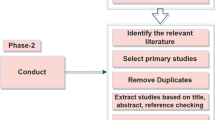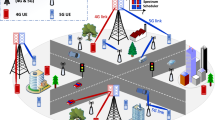Abstract
We consider a cellular scenario in which a base-station primary transmitter communicates to its primary receivers (PRs) using a set of multiple antenna relay stations (RS). One of several RS that is selected is assumed to employ antenna selection. The primary network allows one of its users to access the secondary network simultaneously in the same two phases (by using a selected RS) through dynamic spectrum sharing principles. Such a framework allows the cellular system to increase its frequency utilization. We derive expressions for the outage and ergodic rate performance of such spectrum sharing communication links. Systems performing spectrum sharing are assumed to have a peak power constraint and use peak interference control (to limit interference to the PR). For a fixed primary outage, it is demonstrated that increasing the number of users improves the performance at medium values of SNR, whereas increasing the number of RSs improves the performance at high SNRs.






Similar content being viewed by others
Notes
The outage analysis part of this paper was presented for a different framework in the 7th International Conference on Signal Processing and Communication Systems (ICSPCS), 2013.
Clearly, this number can vary from RS to another, but is taken to be the same in this paper for ease of presentation.
References
da Costa, D., & Aissa, S. (2009). Capacity analysis of cooperative systems with relay selection in nakagami-m fading. IEEE Communications Letters, 13(9), 637639.
Gradshteyn, I. S., & Ryzhik, I. M. (2007). A. Jeffrey, D. Zwillinger (Eds.), Table of integrals, series, and products (7th ed.); Publication Date: March 9, 2007, ISBN-10: 0123736374 ISBN-13, 978-0123736376
Hamdi, K., Zhang, W., & Letaief, K. (2009). Opportunistic spectrum sharing in cognitive MIMO wireless networks. IEEE Transactions on Wireless Communications, 8(8), 4098–4109.
Han, Y., Ting, S. H., & Pandharipande, A. (2012). Cooperative spectrum sharing protocol with selective relaying system. IEEE Transactions on Communications, 60(1), 62–67.
Kartlak, H., Odabasioglu, N., & Akan, A. (2012) Adaptive multiple relay selection and power optimization for cognitive radio networks. In 2012 9th international conference on Communications (COMM), pp. 197, 200, 21–23.
Larsson, E. G. & Stoica, P. Space-time block coding for wireless communications. Cambridge University Press.
Lee, J., Wang, H., Andrews, J. G., & Hong, D. (2011). Outage probability of cognitive relay networks with interference constraints. IEEE Transactions on Wireless Communications, 10(2), 390–395.
Li, F., Bai, B., Zhang, J., & Letaief, K. B. (2011) Location-based joint relay selection and channel allocation for cognitive radio networks. In 2011 IEEE global telecommunications conference (GLOBECOM 2011), pp. 1, 5, 5–9.
Mohan, A., & Prakriya, S. (2013). Performance of dynamic spectrum access with opportunistic selection mechanisms. In 2013 7th international conference on signal processing and communication systems (ICSPCS) pp. 1,7, 16–18.
Papoulis, A., & Unnikrishna Pillai, S. Probability, random variables, and stochastic processes (4th ed.). New Delhi: Tata McGraw Hill.
Tourki, K., Qaraqe, K., & Alouini, M.-S. (2013). Outage analysis for underlay cognitive networks using incremental regenerative relaying. IEEE Transactions on Vehicular Technology, 62(2), 721–734.
Zhang, Y., Zheng, J., & Chen, H.-H. (2010). Cognitive radio networks: Architectures, protocols, and standards. Boca Raton: CRC Press.
Zhao, Q., & Sadler, B. M. (2007). A survey of dynamic spectrum access. IEEE Signal Processing Magazine, 24(3), 79–89.
Acknowledgements
This work was supported by Information Technology Research Academy (ITRA) Ministry of Information Technology, Government of India through sponsored project ITRA/15(63)/Mobile/MBSSCRN/01.
Author information
Authors and Affiliations
Corresponding author
Appendices
Appendix 1
In reference to \(Y={\dfrac{I_{p}}{|g^{II}_{j^{\dagger }l^{\dagger }}|^{2}}}\) in equation (21). CDF of Y can be written as:
Applying the binomial expansion of the term in the integral, and integrating yields the CDF. Finally, derivative of the CDF yields the PDF expression in (22). The CDF \(F_{X}(x)\) of X in Eq. (23) can be derived similarly.
Appendix 2
On using the PDF of X and Y in (24), it can be seen that \({\mathbb{I}}\) is given by:
Using Eq. 3.351-4 of [2]), we obtain (27).
Appendix 3
The assumption taken in asymptotic analysis (34) and ergodic capacity analysis (38) follows \(P_{rp}\gg\sigma ^2\). Based on this assumption the CDFs of \(Y=\frac{I_p}{|g^{II}_{{j^\dagger }{l^\dagger }}|^2} = \frac{P_{rp}|h^{II}_{j^{*}l^{*}}|^{2}}{\gamma _{thp}|g^{II}_{{j^\dagger }{l^\dagger }}|^2}\) and \(X=\frac{ |f_{{k^\dagger }{l^\dagger }}^{II}|^2}{P_{rp} |e_{j^*l^*}^{II}|^2}\) are as follows:
where \(C_1=\frac{m\,P_{rp}\,\lambda _e}{\lambda _f}\), and \(C_2=\frac{\lambda _g\,l\,\gamma _{thp}}{\lambda _h\,N_r\,P_{rp}\,j_s}\).
Using the above expressions to evaluate \(p_{os}^{pno}\) in (17), we get:
where
where \(u=C\gamma _{ths}; \, C=C_1C_2\). Since \(\lim \underset{P_s^{max}\longrightarrow \infty }{p_{os}^{po}}=0\), we have:
Appendix 4
At high SNRs when \(\frac{I_p}{|g^{II}_{j^\dagger l^\dagger }|^2}<P_s^{max}\) the expression in (48) is derived as:
where
Note that \(C_1\) and \(C_2\) are as defined in Sect. 6.
Rights and permissions
About this article
Cite this article
Mohan, A., Prakriya, S. Performance of a Relay Antenna Selection Based Dynamic Spectrum Sharing Protocol with Opportunistic Selection of Users. Wireless Pers Commun 95, 4497–4515 (2017). https://doi.org/10.1007/s11277-017-4097-3
Published:
Issue Date:
DOI: https://doi.org/10.1007/s11277-017-4097-3




